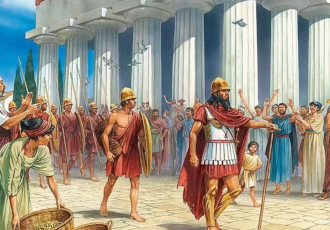
https://www-pronews-gr.translate.goog email: info@pronews.gr Sparta was a city-state in Ancient Greece, built on the banks of the Evrotas River in Laconia, South East Peloponnese. Treasures of ancient Greek art were destroyed and looted, as is known, by Romans, Frankish crusaders, by the Venetian general Morosini and by the Englishman (Scot to be precise) Elgin. Equally great destruction was caused by travelers and emissaries of museums, universities and kings of Europe, who came to Greece during the Turkish rule, to hoard coins, manuscripts, inscriptions and works of art. All of them were surpassed in greed and in the destruction caused to the ancestral treasures of Greece by Abbot Michel Fourmont (1690/1746), envoy of the King of France, Louis XV. Abbe Fourmont surpasses even Elgin in the brutal manner of destroying the monuments, which he literally destroyed, but also in the incredible number of antiquities he destroyed. In his attempt to appear liked by his king and to secure exclusively for him the right of studying and researching inscriptions and monuments, after recording them he indulged in a literally paranoid frenzy in their destruction, even praising it. Fourmont searched for inscriptions in Athens, Salamis, Megara and the Peloponnese, where he even penetrated the wildest parts of Mani. He himself confesses in his manuscript, which survives together with his diary, that he collected over 1,500 inscriptions in his 1729 tour of Greece. In a letter to Count Maurepas, Fourmont boasts that he destroyed the inscriptions, so that they would not be copied by a future traveler What Fourmont writes about the destruction he caused in Sparta also explains the rarity of antiquities today in the famous city. Abbot Fourmont notes the following incredible things: 'for 30 days and more, 30, 40 and 60 workers have been destroying, destroying, destroying the city of Sparta. I have 4 odd towers left to destroy I am currently working on destroying the last antiquities of Sparta. You understand (points to Maurepas) what joy I feel. But Mantinea, Stymphalia, Tegea and especially Nemea and Olympia deserve to be thoroughly destroyed. I have made many marches in search of ancient cities of this country, and have destroyed some. Among them Troizena, Hermione, Tiryntha (tyrins in the manuscript instead of tiryns), half of the citadel of Argos, Phliasia, the feneo I entered Mani. For six weeks now I have been dealing with the total destruction of Sparta Tearing down its walls, its temples, leaving no stone unturned, I will also make its location unknown in the future, so that I can make it known again. This is how I will glorify my journey. Isn't that something?' And below: 'Sparta is the fifth city I excavated. I am now engaged in the destruction of the deeper foundations of the temple of Amyklaios Apollo. I would destroy other ancient sites just as easily if they let me. I completely demolished the tower.' About Troizena he says: 'I demolished what remained of its fortresses and temples.' And with incredible naivety he confesses: 'of the travelers who preceded me, I don't remember anyone daring to demolish towers and other large buildings'. Paranoid, sophomoric, fanatical enemy of the ancient spirit? No one knows the exact answer, maybe a little bit of everything. What is certain, however, is that the destruction it caused is colossal and caused the disappearance of ancient Sparta, Troizena and Hermione. According to the data he gives, in Sparta alone he paid 1,200 daily wages for the demolition of the monuments and buildings that were still standing. One shudders at the thought that Fourmont could have transfered his barbaric menace to Olympia, whose visit he had even planned. But fortunately was recalled to France shortly afterwards. email: info@pronews.gr © pronews.gr 2024